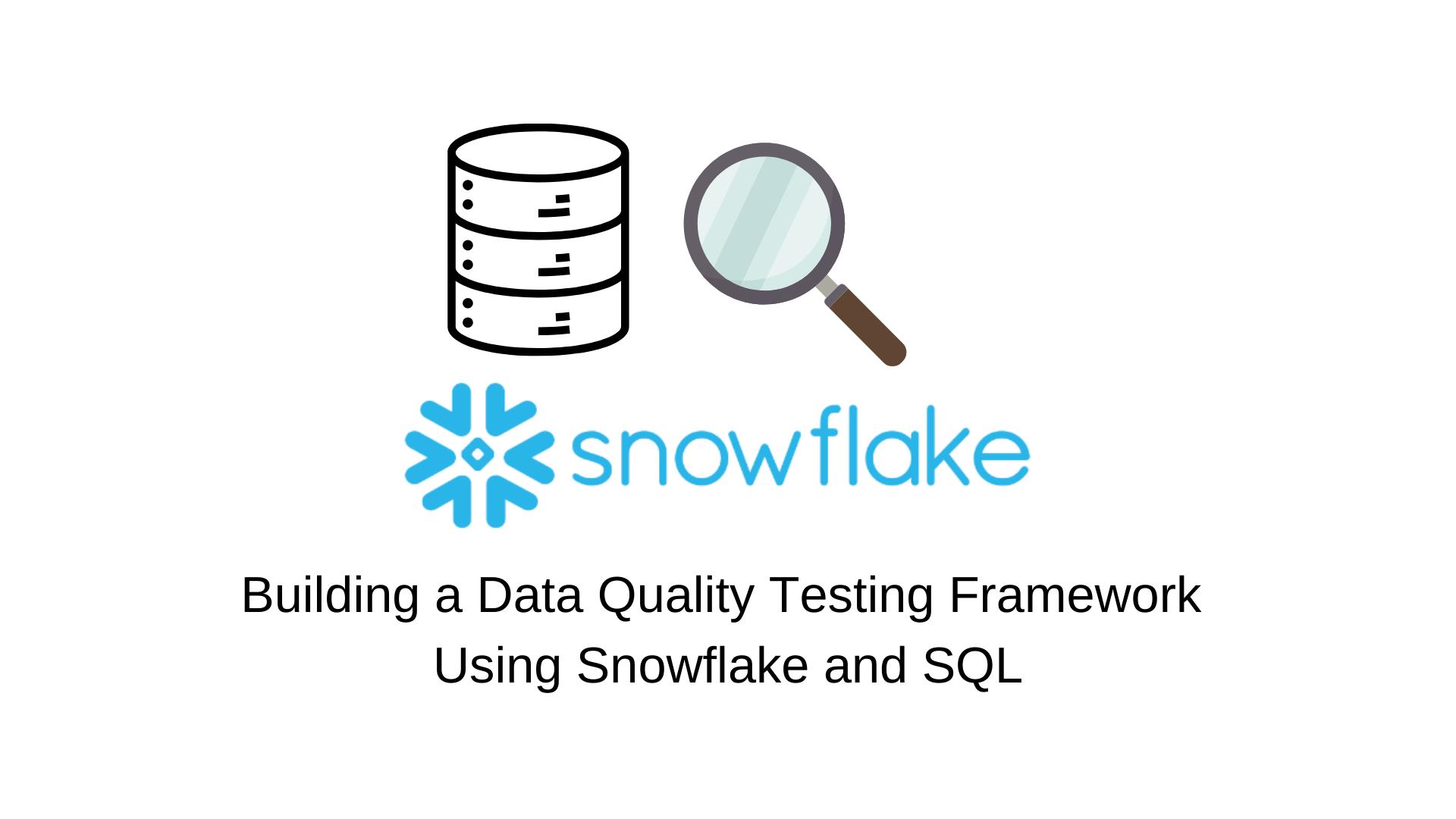Building a Data Quality Testing Framework Using Snowflake and SQL
 Vipin
Vipin
In the era of data-driven decision-making, maintaining high data quality is crucial. Poor data quality can lead to incorrect insights, impacting business decisions. This blog post will guide you through building a robust data quality testing framework using Snowflake and SQL.
Prerequisites
Before diving in, ensure you have the following:
A Snowflake account.
Basic knowledge of SQL.
Familiarity with Snowflake's architecture and features.
Designing the Data Quality Framework
The framework consists of several components:
Data Validation Rules: Define the criteria for data quality.
Error Logging: Capture and store test results and errors.
Reporting: Generate reports to visualize data quality.
Key Data Quality Tests
Null Check: Ensure critical columns do not contain null values.
Range Check: Verify numerical values fall within a specified range.
Format Check: Validate data against a specific format (e.g., email addresses).
Data Quality Tests on customers Table
Step 1: Set Up the customers Table
Assume we have a customers table with the following structure:
CREATE OR REPLACE TABLE customers (
customer_id INT,
name STRING,
email STRING,
age INT,
signup_date DATE
);
INSERT INTO customers (customer_id, name, email, age, signup_date) VALUES
(1, 'John Doe', 'john.doe@example.com', 28, '2023-01-15'),
(2, 'Jane Smith', NULL, 22, '2023-02-20'),
(3, 'Alice Johnson', 'alice.johnson@example', 35, '2023-03-10'),
(4, 'Bob Brown', 'bob.brown@example.com', -5, '2023-04-05'),
(5, 'Carol White', 'carol.white@example.com', 42, '2023-05-12');
Implementing Data Quality Tests
Step 1: Create a Data Quality Rules Table
First, create a table to store your data quality rules. This table can include columns for the rule name, SQL query, and any additional metadata you might need.
CREATE OR REPLACE TABLE data_quality_rules (
rule_id INT AUTOINCREMENT,
rule_name STRING,
sql_query STRING,
error_message STRING
);
Step 2: Insert Data Quality Rules
Insert your data quality rules into the data_quality_rules table. You can store the SQL queries as strings:
INSERT INTO data_quality_rules (rule_name, sql_query, error_message) VALUES
('Null Check',
'SELECT COUNT(*) AS error_count FROM customers WHERE email IS NULL',
'Null values found in email column'),
('Range Check',
'SELECT COUNT(*) AS error_count FROM customers WHERE age NOT BETWEEN 0 AND 120',
'Out of range values in age column'),
('Format Check',
'SELECT COUNT(*) AS error_count FROM customers WHERE NOT REGEXP_LIKE(email, ''^[A-Za-z0-9._%+-]+@[A-Za-z0-9.-]+\\.[A-Za-z]{2,}$'')',
'Invalid email format');
Step 3: Create a Table for Results
Create a results table to store the output of the data quality checks:
CREATE OR REPLACE TABLE data_quality_results (
rule_name STRING,
error_count NUMBER,
error_message STRING,
test_timestamp TIMESTAMP
);
Step 4: Execute Data Quality Rules
You can write a SQL script or use a stored procedure to iterate over the rules in the data_quality_rules table and execute them dynamically. Here’s an example of how to do this using a loop in a stored procedure:
CREATE OR REPLACE PROCEDURE run_data_quality_checks()
RETURNS STRING
LANGUAGE JAVASCRIPT
AS
$$
var sql_command;
var stmt;
var results;
// Clear previous results
sql_command = "TRUNCATE TABLE data_quality_results;";
stmt = snowflake.createStatement({sqlText: sql_command});
stmt.execute();
// Retrieve rules
sql_command = "SELECT rule_name, sql_query, error_message FROM data_quality_rules;";
stmt = snowflake.createStatement({sqlText: sql_command});
results = stmt.execute();
while (results.next()) {
var rule_name = results.getColumnValue(1);
var query = results.getColumnValue(2);
var error_message = results.getColumnValue(3);
// Execute the query
stmt = snowflake.createStatement({sqlText: query});
var query_results = stmt.execute();
if (query_results.next()) {
var error_count = query_results.getColumnValue(1);
// Insert results into the results table
sql_command = `INSERT INTO data_quality_results (rule_name, error_count, error_message, test_timestamp)
VALUES ('${rule_name}', ${error_count}, '${error_message}', CURRENT_TIMESTAMP);`;
stmt = snowflake.createStatement({sqlText: sql_command});
stmt.execute();
}
}
return "Data quality checks completed.";
$$;
Step 5: Run the Stored Procedure
You can run the stored procedure whenever you want to execute all the data quality checks:
CALL run_data_quality_checks();

Step 6: View the Results
After running the checks, you can view the results:
SELECT * FROM data_quality_results;

Future Enhancement:
The framework can be enhanced to include additional data quality check scenarios, such as the following:
1. Uniqueness Checks
Ensure that specific columns that should have unique values (e.g., primary keys, email addresses) do not contain duplicates.
SELECT
customer_id, COUNT(*)
FROM
customers
GROUP BY
customer_id
HAVING
COUNT(*) > 1;
2. Consistency Checks
Ensure that related fields have consistent values. For example, the state and zip code should match within the same geographical area.
SELECT
COUNT(*)
FROM
customers
WHERE
(state = 'CA' AND NOT zip_code LIKE '9%')
OR (state = 'NY' AND NOT zip_code LIKE '1%');
3. Referential Integrity Checks
Verify that foreign keys in the table refer to existing records in related tables.
SELECT
c.customer_id
FROM
customers c
LEFT JOIN
orders o ON c.customer_id = o.customer_id
WHERE
o.customer_id IS NULL;
4. Pattern Checks
Ensure that the values in certain columns follow a specific pattern or format, such as email addresses or phone numbers.
SELECT
email
FROM
customers
WHERE
email NOT LIKE '%_@__%.__%';
5. Length Checks
Ensure that string data does not exceed the expected length.
SELECT
customer_id, first_name, last_name
FROM
customers
WHERE
LENGTH(first_name) > 50
OR LENGTH(last_name) > 50;
6. Statistical Distribution Checks
Compare the distribution of data to expected distributions. For example, ensuring that the distribution of ages in the customers table follows a reasonable pattern.
SELECT
AVG(age), MIN(age), MAX(age)
FROM
customers;
7. Anomaly Detection
Identify outliers or anomalies in your data that deviate significantly from the norm.
WITH stats AS (
SELECT
AVG(order_amount) AS avg_amount,
STDDEV(order_amount) AS stddev_amount
FROM
orders
)
SELECT
order_id, order_amount
FROM
orders, stats
WHERE
ABS(order_amount - stats.avg_amount) > 3 * stats.stddev_amount;
8. Completeness Checks
Ensure that mandatory fields are not null.
SELECT
customer_id
FROM
customers
WHERE
first_name IS NULL
OR last_name IS NULL;
9. Timeliness Checks
Verify that dates and times are within expected ranges and that there are no future dates in historical records.
SELECT
order_id, order_date
FROM
orders
WHERE
order_date > CURRENT_DATE;
10. Cross-Field Validation
Ensure that the values in one field are logically consistent with the values in another field.
SELECT
customer_id, start_date, end_date
FROM
subscriptions
WHERE
end_date < start_date;
11. Dependency Checks
Ensure that the presence of one field's value is dependent on another field's value.
SELECT
customer_id, email, email_opt_in
FROM
customers
WHERE
email_opt_in = 'Y' AND email IS NULL;
By incorporating these additional checks, you can significantly enhance your data quality framework and ensure that your data remains accurate, consistent, and reliable. Make sure to regularly review and update these checks based on your evolving data quality requirements and business rules.
Best Practices
Regular Updates: Review and update data quality rules periodically.
Monitor Trends: Keep an eye on data quality trends and address issues promptly.
Scale: Adapt the framework to handle increasing data volumes.
Conclusion
Ensuring data quality is a continuous process. Using Snowflake and SQL, you can build a flexible and powerful data quality testing framework to maintain the integrity of your data. Implement this framework, customize it to your needs, and ensure your data remains reliable and accurate.
Additional Resources
Subscribe to my newsletter
Read articles from Vipin directly inside your inbox. Subscribe to the newsletter, and don't miss out.
Written by

Vipin
Vipin
Highly skilled Data Test Automation professional with over 10 years of experience in data quality assurance and software testing. Proven ability to design, execute, and automate testing across the entire SDLC (Software Development Life Cycle) utilizing Agile and Waterfall methodologies. Expertise in End-to-End DWBI project testing and experience working in GCP, AWS, and Azure cloud environments. Proficient in SQL and Python scripting for data test automation.